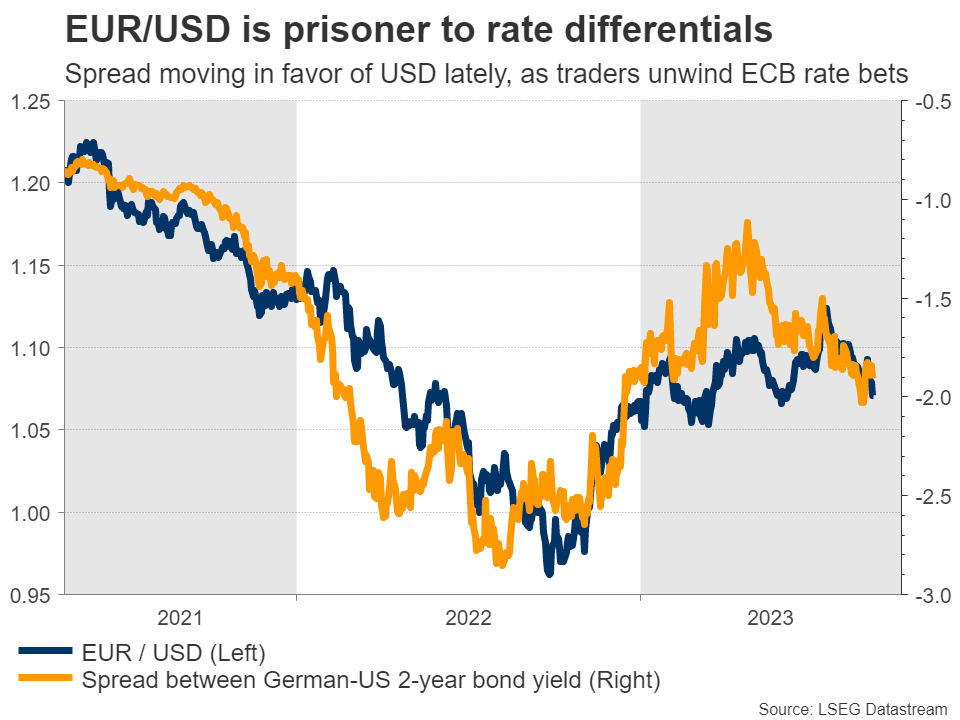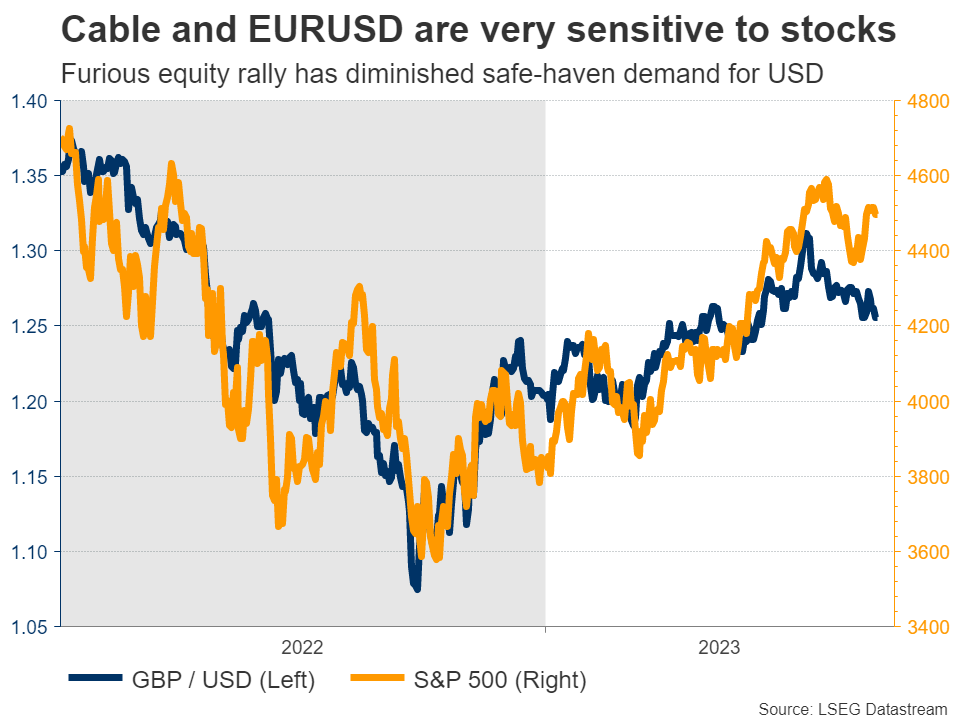It is crystal clear that the United States has the superior economy at this stage of the cycle, especially when compared to Europe or China. And yet, this economic strength has not translated into a full-scale US dollar rally. What’s the missing ingredient for that to change?
Growth differentials
There’s been a striking divergence in the performance of major economies this year. The United States is currently the bright spot. Economic growth seems to have accelerated over the summer and is on track to hit an annualized 5.6% this quarter according to the Atlanta Fed. That’s mostly because consumers are still spending, with some help from real wage growth returning to positive territory.
Similarly, the labor market is still in good shape. Although there are some signs that jobs growth is cooling off, that’s natural as the US economy is already beyond full employment conditions. Even the housing market has staged a stunning recovery, with home prices hitting new record highs in much of the country despite sky-high borrowing costs.
In stark contrast, storm clouds are gathering over Europe and China. With global manufacturing going through a pandemic-fueled hangover, manufacturing hubs like Germany and China have been hit particularly hard, putting the brakes on economic growth.
Business surveys suggest this slowdown will persist and might even conclude with a mild recession, at least in the Eurozone. And while China might dodge a recession, it could still be stuck in a slow-growth environment for years as it deals with the painful deleveraging of its property sector that is experiencing a serious debt crisis.
China’s troubles have implications for other economies as well. Take Australia and New Zealand. These economies rely on Chinese demand to absorb their commodity exports, so if Chinese growth is almost stagnant, it can have negative spillovers on these economies and their currencies.
So why is the dollar not king?
Admittedly, the US dollar did power higher in recent weeks, but it’s almost flat for the year, so the latest gains have not been very impressive. One element behind the dollar’s inability to stage a fierce rally is how aggressively foreign central banks raised interest rates.
Although European yields are still below American ones, the gap has narrowed considerably, making the euro more attractive by comparison. That said, this euro-friendly yield compression has already started to unwind. The Eurozone’s economic data pulse is slowing at an alarming pace, which will inevitably affect monetary policy decisions.
In other words, European Central Bank officials cannot ignore a weaker growth profile for much longer. In fact, the central bank might pause its tightening cycle this month already, as several policymakers seem worried a recession is brewing. In this case, the euro could receive more bruises.
How oil prices evolve will be extremely important for FX markets too. Since the Eurozone and Japan import almost all their energy from abroad, a spike higher in oil prices tends to hurt those currencies, by impacting the terms of trade of their economies and restricting growth.
Therefore, if the recent supply-driven spike in oil prices continues, that would be detrimental for both the euro and the yen. In the yen’s case, there’s also the massive gap in interest rate differentials to consider, as the Bank of Japan refuses to abandon negative rates even in this inflationary environment.
Last but not least, the cheerful tone in stock markets this year has been a crucial factor in holding back the safe-haven US dollar, while benefiting the likes of the British pound and to a lesser extent the euro. This means that any correction in high-flying stocks could also inflict collateral damage on euro/dollar and sterling/dollar.
‘All weather’ currency
All told, the US economy and by extension the dollar seem more attractive than any alternatives. This economic resilience has started to be reflected in the bond market as well, with US yields spiraling higher. Hence, the greenback has transformed into an ‘all weather’ currency again, offering a combination of high yields and safety thanks to its reserve currency status.
On the flip side, the outlook for other currencies is darker. Europe and China are plagued by slowing growth, the Japanese yen has been ravaged by rate differentials, and the British pound is trading like a proxy for equity markets, leaving it vulnerable to shifts in risk sentiment. Keep in mind that FX is a relative game, so the dollar inevitably benefits if other currencies struggle.
Over the last year, the FX market has been trading almost entirely on interest rate differentials. However, with most major central banks about to conclude their tightening cycles, the next dominant theme might be economic growth differentials, which clearly favor the United States at this stage. Ultimately, capital does not flow into distressed economies.
In this sense, the missing link for a powerful US dollar rally might be a correction lower in stock markets that fuels demand for safe haven plays. With valuations historically stretched and earnings growth stagnant in an environment where US yields are pressing higher and global growth is losing steam, that’s a real possibility.
Forex trading and trading in other leveraged products involves a significant level of risk and is not suitable for all investors.
Recommended Content
Editors’ Picks

EUR/USD extends recovery beyond 1.0400 amid Wall Street's turnaround
EUR/USD extends its recovery beyond 1.0400, helped by the better performance of Wall Street and softer-than-anticipated United States PCE inflation. Profit-taking ahead of the winter holidays also takes its toll.

GBP/USD nears 1.2600 on renewed USD weakness
GBP/USD extends its rebound from multi-month lows and approaches 1.2600. The US Dollar stays on the back foot after softer-than-expected PCE inflation data, helping the pair edge higher. Nevertheless, GBP/USD remains on track to end the week in negative territory.

Gold rises above $2,620 as US yields edge lower
Gold extends its daily rebound and trades above $2,620 on Friday. The benchmark 10-year US Treasury bond yield declines toward 4.5% following the PCE inflation data for November, helping XAU/USD stretch higher in the American session.

Bitcoin crashes to $96,000, altcoins bleed: Top trades for sidelined buyers
Bitcoin (BTC) slipped under the $100,000 milestone and touched the $96,000 level briefly on Friday, a sharp decline that has also hit hard prices of other altcoins and particularly meme coins.

Bank of England stays on hold, but a dovish front is building
Bank of England rates were maintained at 4.75% today, in line with expectations. However, the 6-3 vote split sent a moderately dovish signal to markets, prompting some dovish repricing and a weaker pound. We remain more dovish than market pricing for 2025.

Best Forex Brokers with Low Spreads
VERIFIED Low spreads are crucial for reducing trading costs. Explore top Forex brokers offering competitive spreads and high leverage. Compare options for EUR/USD, GBP/USD, USD/JPY, and Gold.



